CONSERVATION AT WORK
The Pennsylvania Fish and Boat Commission is committed to protecting and conserving PA's natural resources. Check out some of our latest projects to protect our waterways and wildlife. (And, learn more about our habitat improvement programs.)
REMOVE A DAM IMPROVE A STREAM
Muddy Run Tributary, Lancaster County
Creating and enhancing habitat for fish and other aquatic life and improving stream health is a never-ending job. Fortunately, the Pennsylvania Fish and Boat Commission has great partners who eagerly take on the work, too. Our partner and grant recipient, Lancaster County Conservation District (LCCD), spent a few days in May removing a dam and stream crossing and improving the land (planting a riparian buffer) around this unnamed tributary to Muddy Run in Lancaster County.
The dam and stream crossing made it difficult for aquatic organisms to pass, and they contributed to erosion problems in the stream.
The project was funded by our York and Lancaster Counties Habitat Improvement Grant Program. The program is supported by the Peach Bottom Atomic Power Station and the Muddy Run Pumped Storage Facility projects providing $150,000 annually for projects such as dam removals, stream habitat improvement projects, and agricultural pasture and barnyard best management practices in York and Lancaster Counties.
This project will also include installing livestock exclusion fencing later this year.
Check out this time lapse video LCCD captured while working on the project.
ENHANCING TURTLE HABITAT WITH NEW BASKING PLATFORM DESIGN AT SHAWNEE STATE PARK
It's a great time to be a turtle on Shawnee Lake. Pennsylvania Fish and Boat Commission biologists have upgraded turtle basking platforms in the southwest PA state park lake.
The thermal image illustrates how painted turtles are drawn to the warmth of the new basking platforms.. It's not just a better design; it's a testament to our unwavering commitment to conservation.

Traditionally, our designs relied on PVC and stainless-steel fasteners that would only 5-10 years in lake conditions. Two years ago, our smart scientists revolutionized our approach and introduced this new PFBC design. The alternative materials not only to ensure longevity but are also easier for our turtle populations to access.

The updated design isn't just about durability; it's about inclusivity. While designed with turtles in mind, our platforms provide sanctuary for a diverse array of wildlife. Fish seek refuge beneath the overhead cover and even birds perch there.
Our dedication to habitat improvement extends beyond structural enhancements. The felled trees you see in the water are integral to our holistic approach, serving as vital components of our habitat improvement program.
NEW LIFE TO ONCE IMPAIRED STREAMS IN THE TURTLE CREEK WATERSHED
A Partnership Success Story
In April 2024, 2.2 miles of streams in the Turtle Creek Watershed in Union County officially got a new lease on life when they were removed from the “impaired" waterways list. Their reinvigoration wasn't sudden, though. It is the result of a 10-year commitment and the hard work of the Northcentral Stream Restoration Partnerships. For the Pennsylvania Fish and Boat Commission Habitat Management Division, collaboration with partners Northcentral Pennsylvania Conservancy, the Pennsylvania Department of Environmental Protection, County Conservation Districts, and willing landowners have been paramount to the success of the project and new life to the streams.
Much of the work has focused on reducing sediment by stabilizing banks, improving habitat in the streams, and stabilizing the land around the streams. Improvements to livestock access to streams means farmers will have sustainable healthy and accessible water sources. And the healthier streams means the watershed will support fish and aquatic life and habitats.
With more work to be done in the watershed to improve habitats, the project and partnership will continue. The project is funded in part by federal, state and private grants. To learn more about the project, check out this informative and engaging story map.
Highlights of restoration work to date:
- 1,368 Stream Stabilization Structures Installed
- 10,927 feet of Streambank Fencing Installed
- 19 Stabilized Stream Crossings Installed
- 21,964 feet of Stream Length Impacted by Turtle Creek Restoration Work to Date
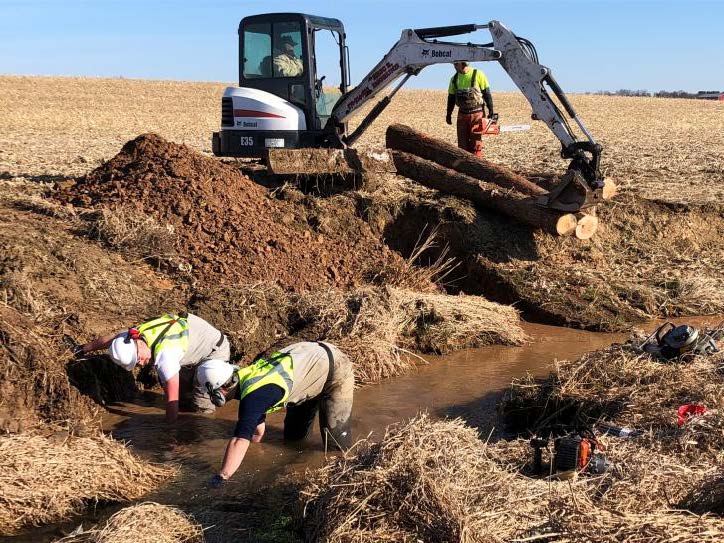
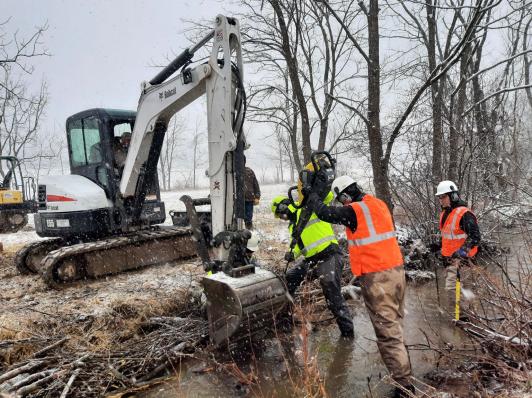
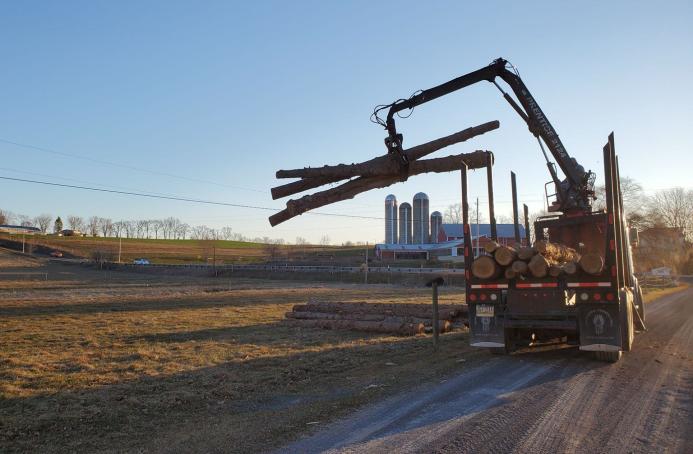
TIMELAPSE OF IMPROVED STREAM HABITAT, MILL CREEK, WESTMORELAND COUNTY
The PFBC partnered with the
Loyalhanna
Watershed Association and PennDot to complete a project on Mill Creek, located in
Ligonier, PA near Pittsburgh. Mill creek
is a stocked trout fishery that also supports natural reproduction in the
headwaters. Mill Creek is a cold-water
tributary that enters the Loyalhanna Creek in the special regulation area of
the “Keystone Select Trout.”
The
project enhanced a section of Mill Creek in proximity to its mouth to the
Loyalhanna. The project area includes
two highway bridges that led to this section of the stream to be 2.5 times it’s
natural stream width, which led to a void stream habitat and trout fishery. The average
stream depth was less than 6 inches deep and led to fish passage issues in the
summer months. As a result, the stream would warm up too much to offer relief to fish found in these waters.
The
PFBC stream habitat design and project included the installation of 3 rock
cross vanes and established a vegetated buffer, which provides shade and a health riparian zone for other species. Overall, the stream was able to maintain a
clean healthy stream bottom and channel that remains cool. Over time, the average
depth deepened to more than 2 feet and the vegetated buffer was built at low
bank height elevation, improving the flood capacity. There is now a viable
trout fishery in this section that would support year-round fishing.
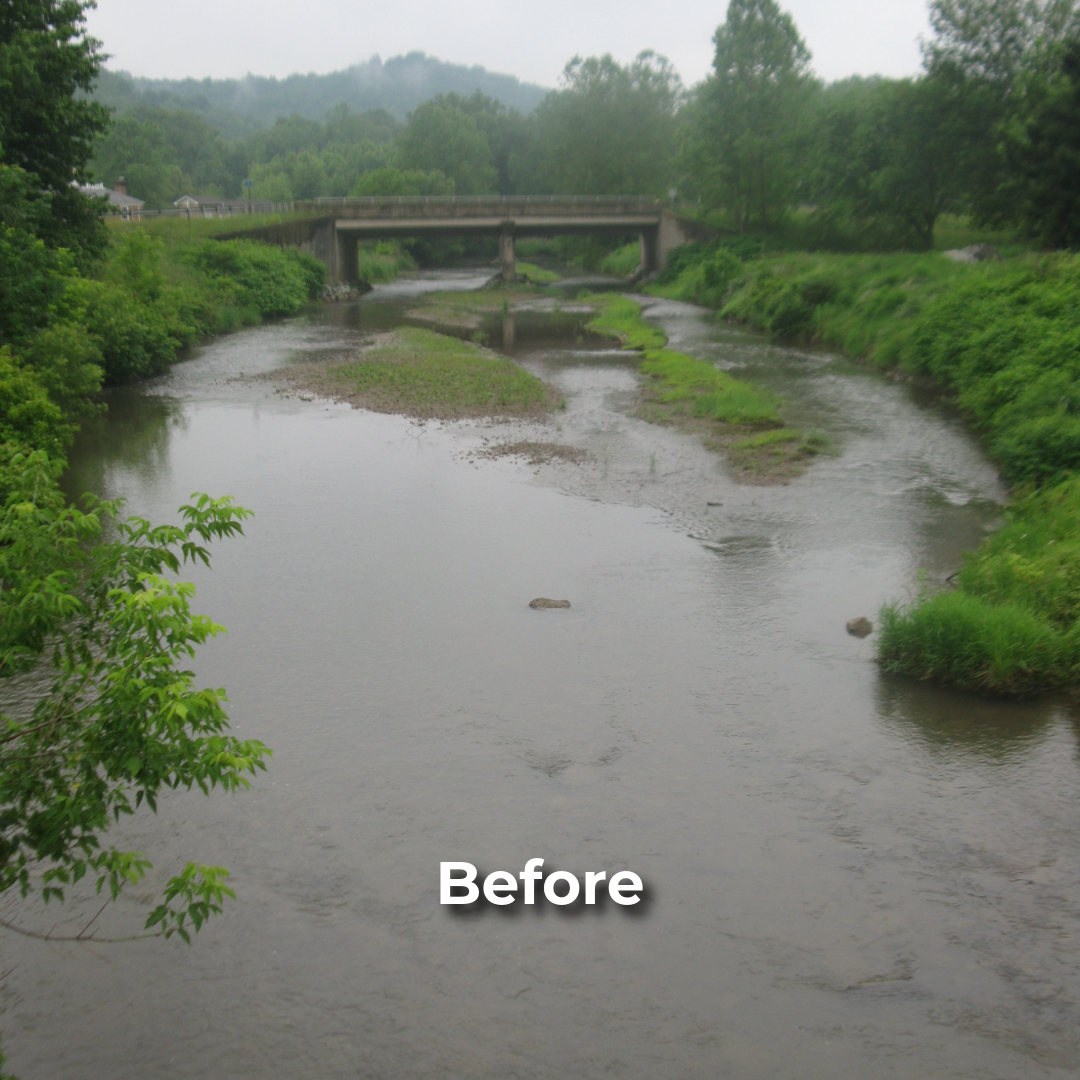
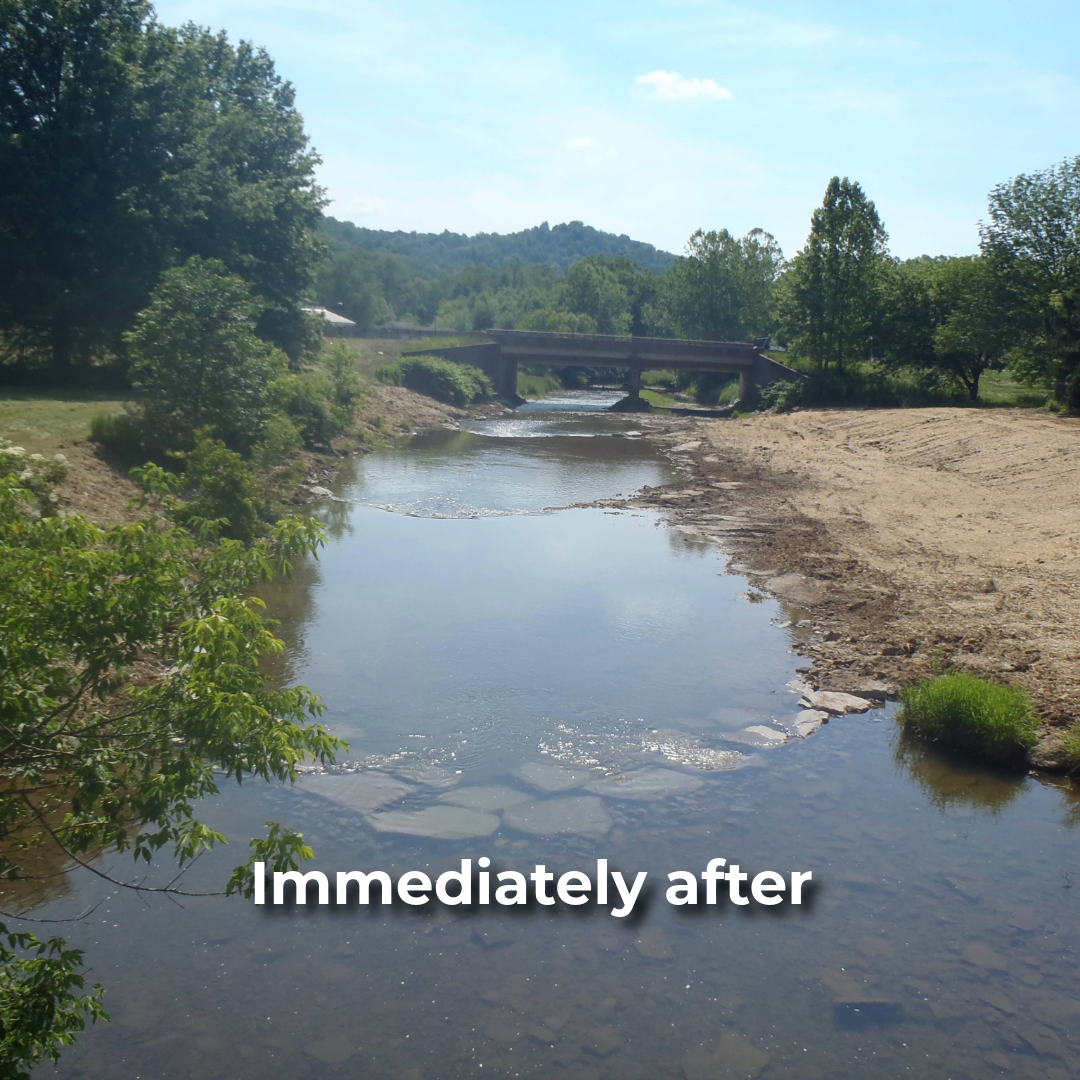
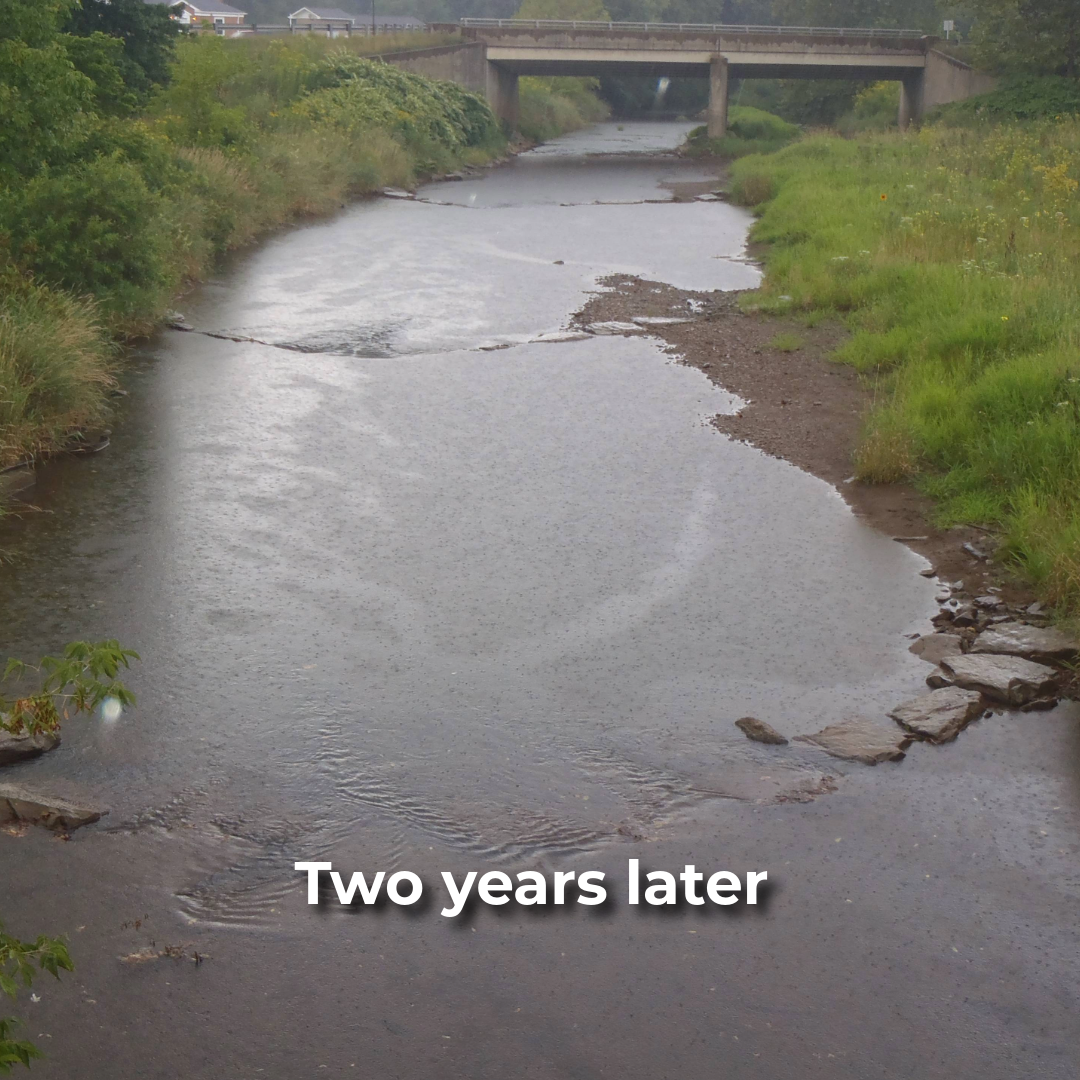
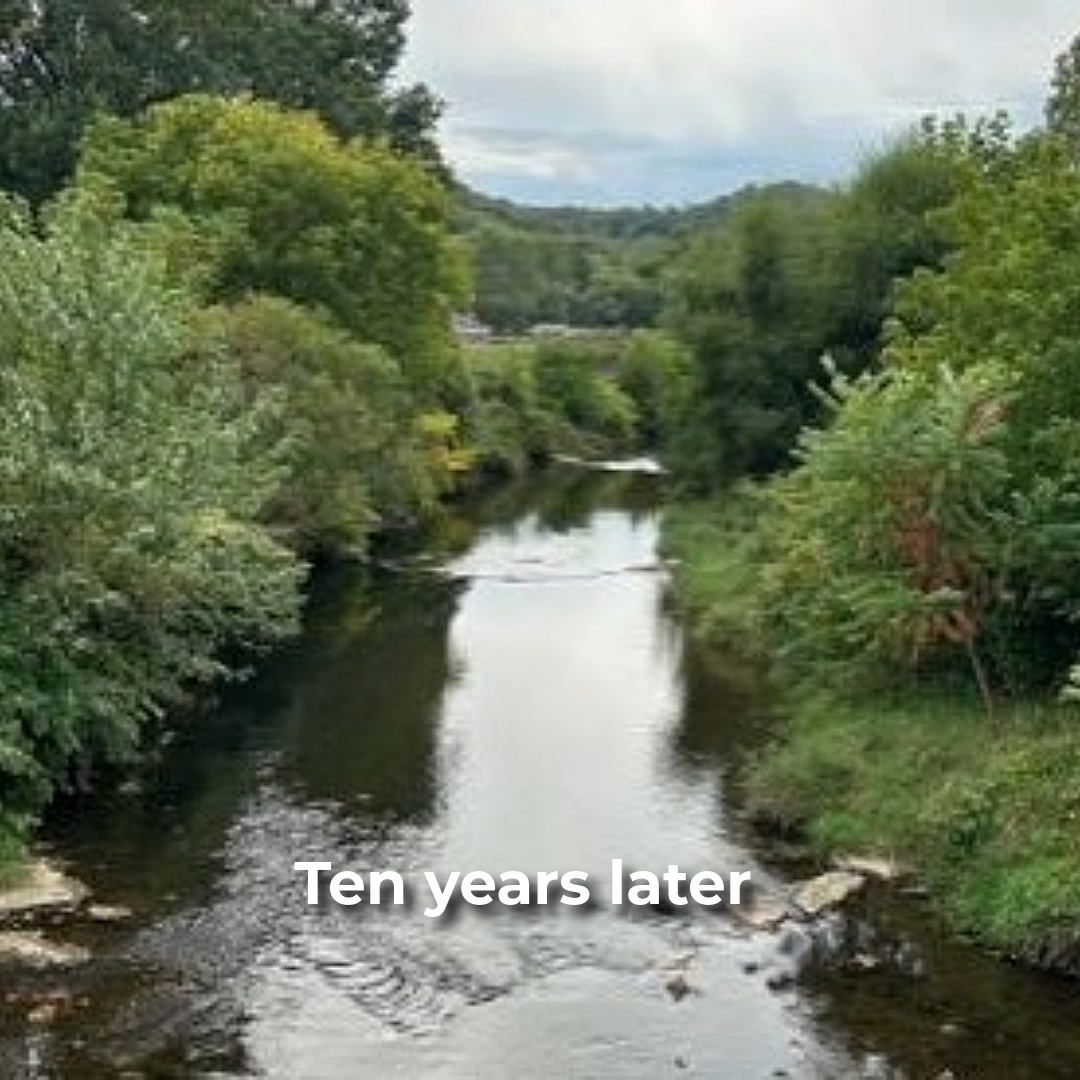
Photo Caption: The below photos above show the progression from the previous poor conditions and the vast improvement over a ten year
period.
IMPROVED HABITAT FOR KISHAQUILLAS CREEK
The PFBC partnered with the Mifflin County Conservation District to complete a project on Kishaquillas Creek, located near Belleville, PA. The project included the installation of 6 single log vane structures, 5 log framed stone deflectors, 140' of modified mudsill, and 300 tons of stone. These structures will provide better riffle, run, and pool habitat with overhead cover and bank stabilization. Following the completion of the stream habitat restoration work, an agricultural crossing and new fencing were installed as additional best management practices for the farmer. The project took 5 days to complete.
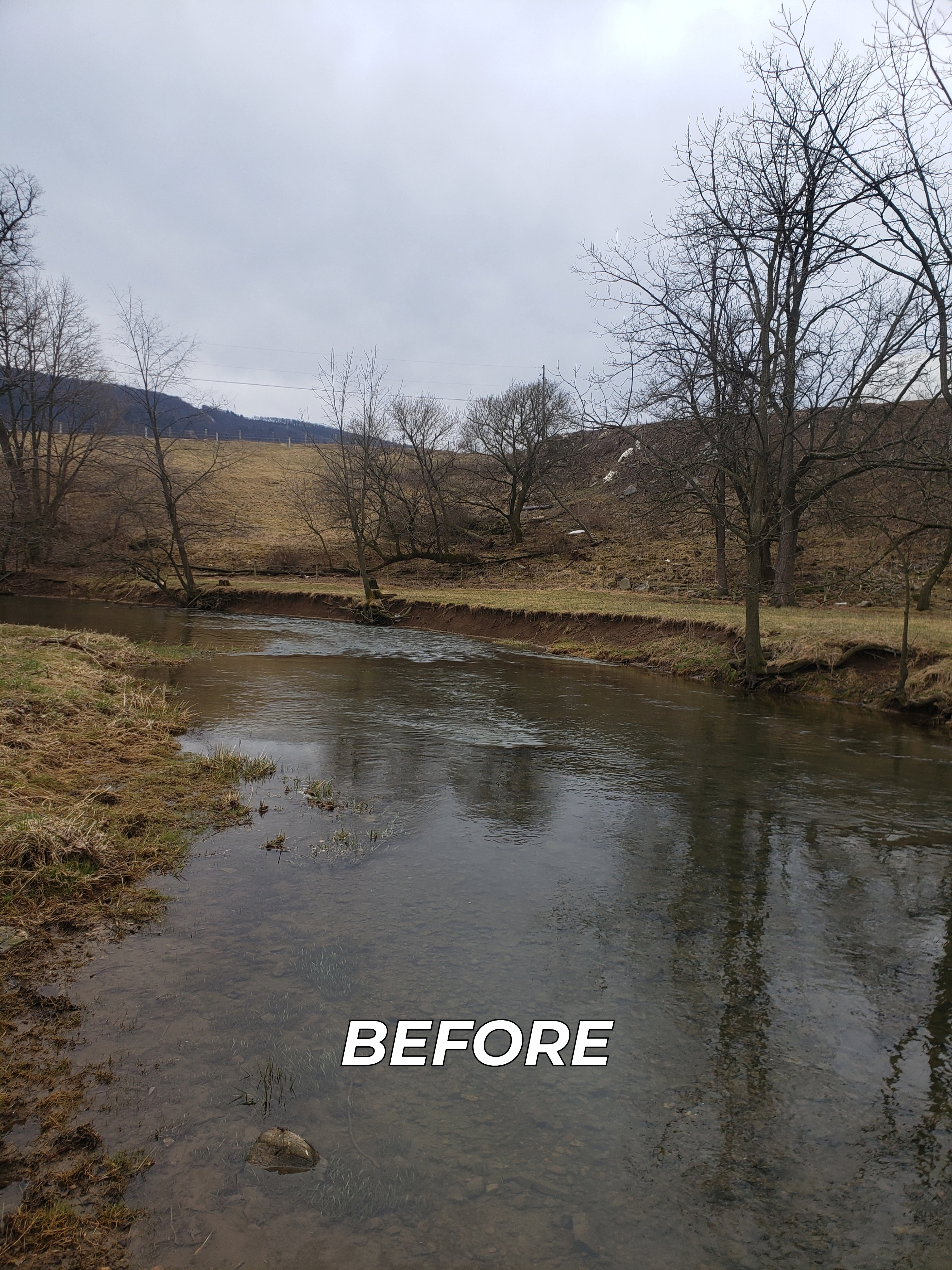
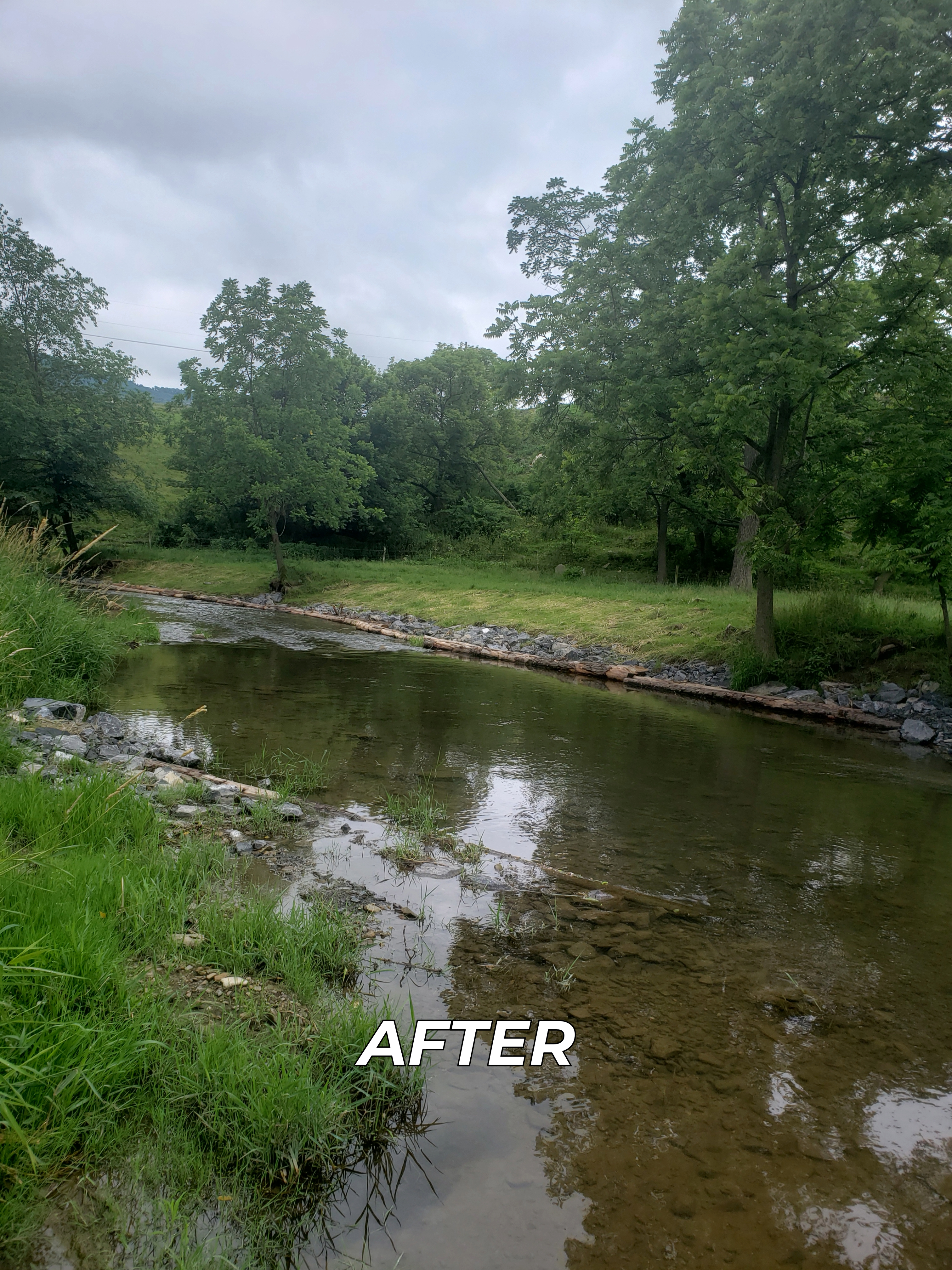
Before Photo: Shows a 140 foot long by 6 foot vertically eroding bank. This bank was a contributing factor to sediment and nutrient pollutions to the creek.
After Photo: Shows a PFBC design and built modified mud sill that provides overhead cover habitat for fish species as well as stabilizing and preventing excess sediment and nutrients from entering the creek.
WOODCOCK CREEK LAKE HABITAT IMPROVEMENT PROJECT
Hey Fish, PLAY BALL!
That may as well be what we tell the fish in Woodcock Lake in Crawford County about their new habitat structures.
The Pennsylvania Fish and Boat Commission (PFBC), along with partners, Woodcock Township, United States Army Corps of Engineers and Earth Shapers Construction Company placed these 69 Concrete Reef Ball Structures into Woodcock Lake as habitat for larger game fish species. This lake has a mostly featureless mud bottom, so the Reef Balls will offer exceptional cover for the fish.
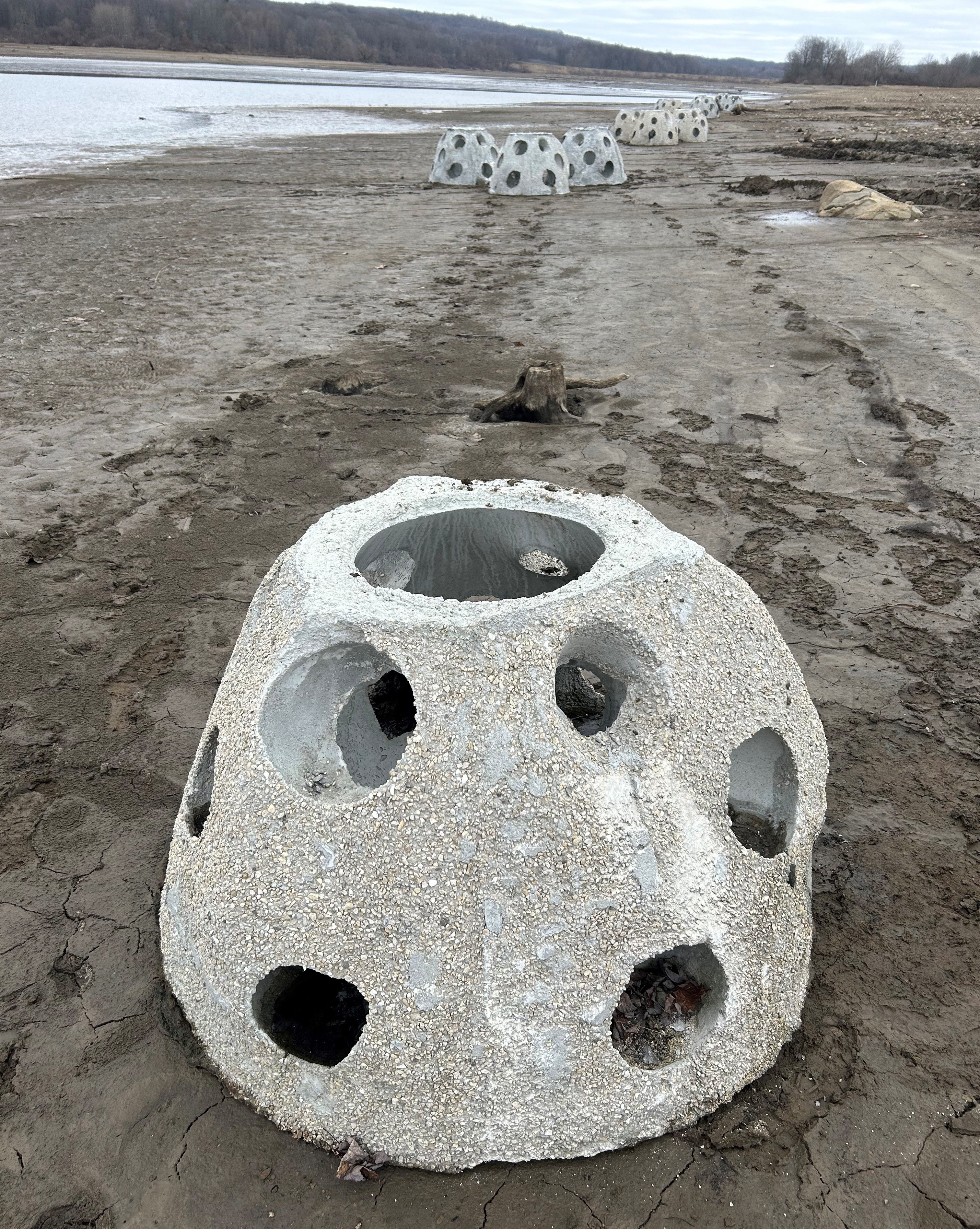
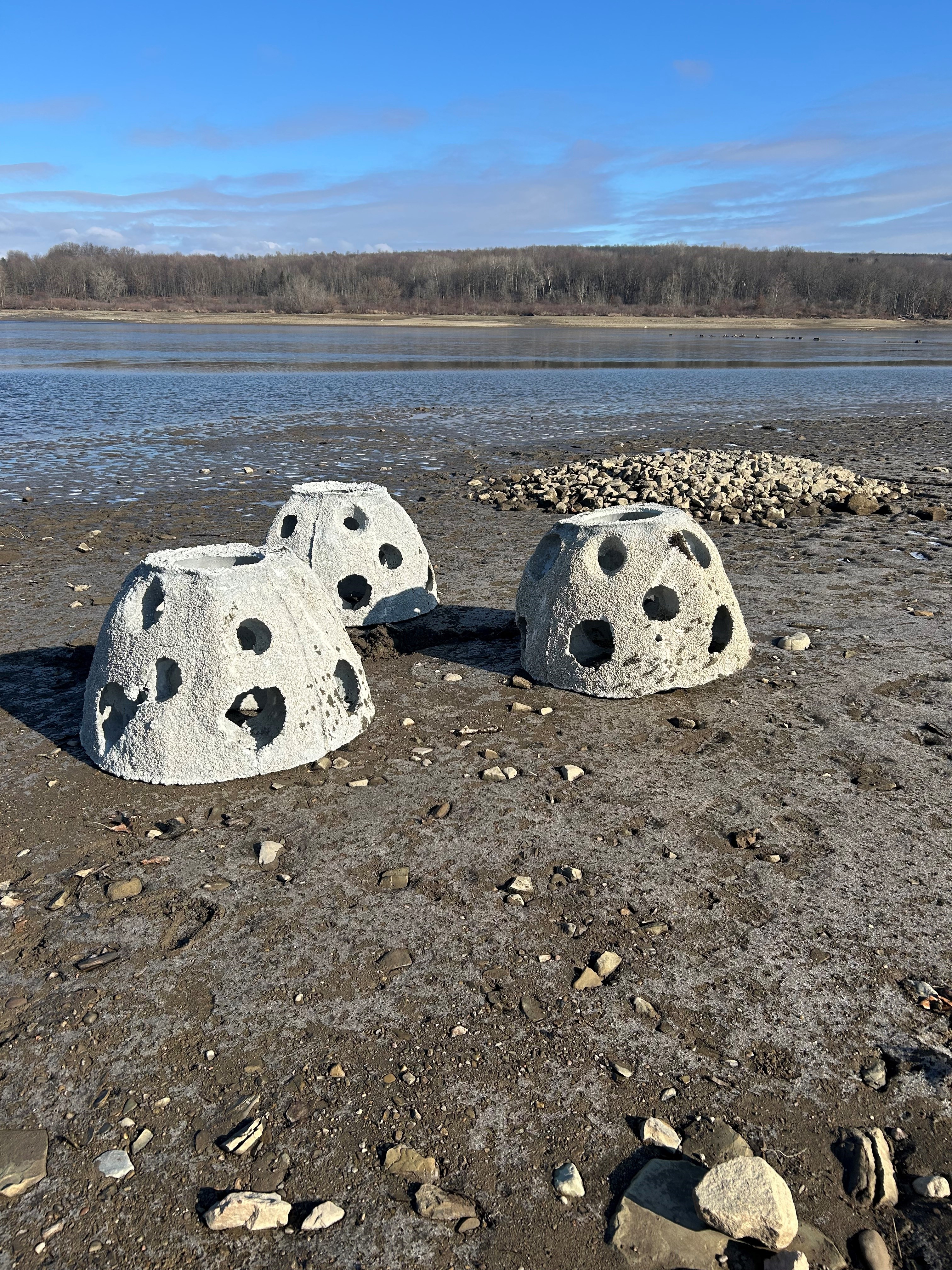
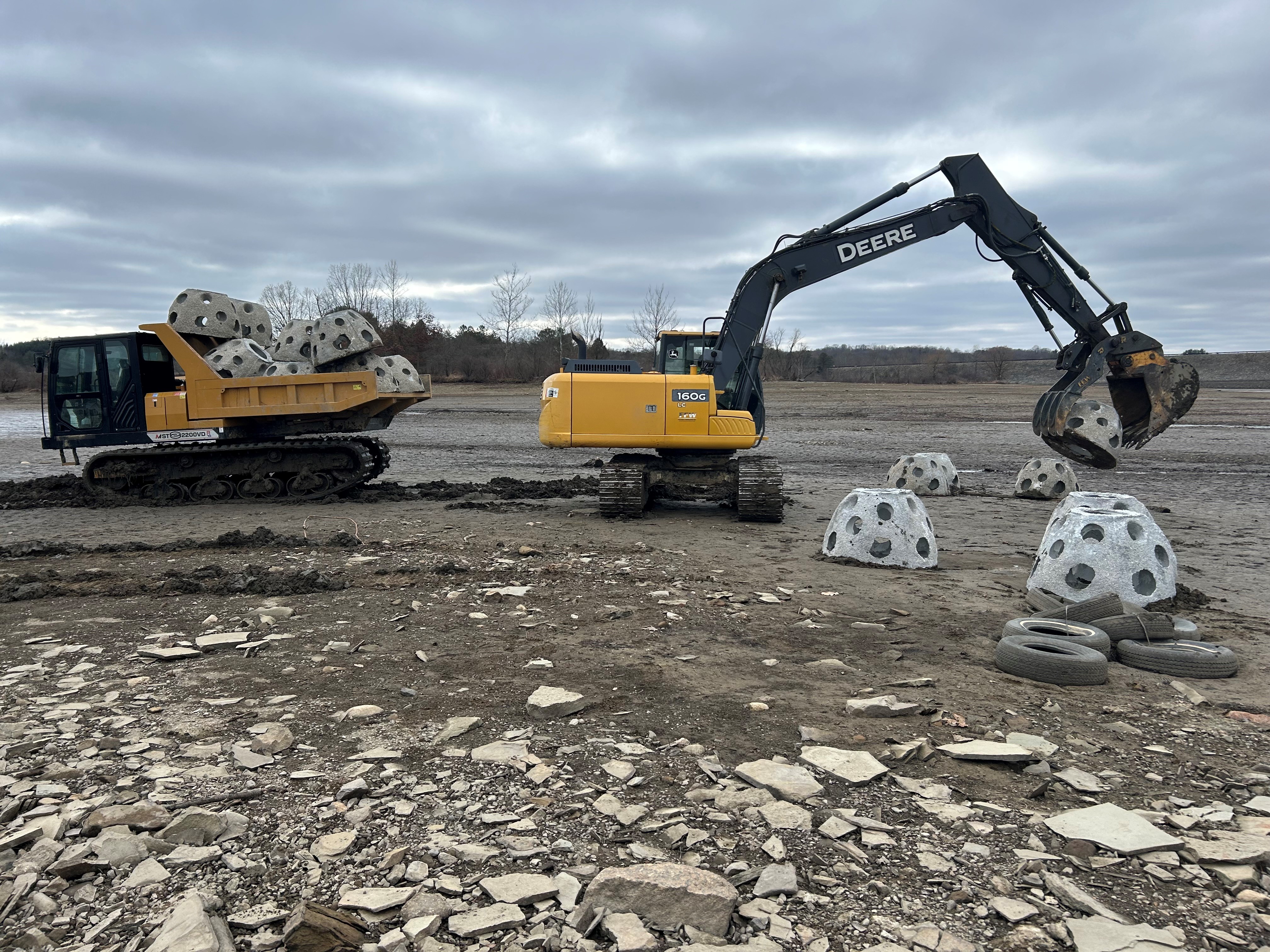
Partners are also adding to the lakes' aquatic habitat placing more than 260 tons of Rock Rubble Humps. The humps give cover to fish species and improve macroinvertebrate species, enhancing foraging for fish.
Great news for the aquatic species found at the lake and anglers looking for fishing opportunities when the lake is refilled.
OAKLAND DAM REMOVAL: LARGEST EVER IN PA
In Summer and Fall 2023, American Rivers, with the support of the Pennsylvania Fish and Boat Commission (PFBC) and numerous partners, opened more than 200 miles of waters when they removed the Oakland Dam from the North Branch Susquehanna River. To say it was a big project would be an understatement. “To the best of my knowledge, it is the largest PA dam removal to date, at least in modern times," said David Dippold, the Commission's fish passage biologist.
As remarkable as this feat was, (take a look at the timelapse video of the months long project) removing this dam is just another of a long list. “Pennsylvania is a national leader in dam removals, leading the country in the total number of dams removed." In fact, American Rivers whose goal is to remove harmful dams across the United States, reports that Pennsylvania's removals more than double that of the next highest state.
“Our success as a state in dam removals is primarily due to the vast network of conservation organizations and state agencies that work to remove dams across the state," Dippold said. Oakland Dam is no exception. American Rivers was the project manager, but the partner list includes the Boroughs of Susquehanna and Oakland, Endless Mountains Heritage Region, Upper Susquehanna Coalition via Tioga County Soil and Water Conservation District, United States Fish and Wildlife Service, Pennsylvania Department of Environmental Protection, the U.S. Army Corps of Engineers, Pennsylvania Department of Conservation and Natural Resources, Pennsylvania Department of Community and Economic Development, River Bounty and Susquehanna County.
TIMBER RATTLESNAKE MANAGEMENT
PFBC biologists study Timber Rattlesnakes in Pennsylvania, searching for these snakes in places they've been found and tagged dating back to the 1990s and early 2000s. They capture and quickly assess snakes to look for major injuries or snake fungal disease, measure the snake and count the subcaudal scales to identify its sex. If it’s a female, they also check to see if she is pregnant or recently had a litter.
As the agency with jurisdiction over reptiles and amphibians in Pennsylvania, the PFBC sets regulations to manage native species. Timber Rattlesnakes are among the Commission's most managed non-game species. Read more.
BEFORE AND AFTER ON SCHWABEN CREEK
Why do we install stream habitat structures?
Here’s a great before and after to show improvements on Schwaben Creek, Northumberland County. The before photo taken in February 2022 shows a 5-foot-high eroding stream bank. A modified mud sill was placed in June 2022, and the after photo was taken in November 2022.
The modified mud sill provides overhead cover habitat in pools and stabilizes the stream bank to prevent sediment erosion. The larger sloped bank catches excess phosphorous and nitrogen, which is important to water quality and stream health.
Staff built 31 PFBC habitat improvement devices over 1,900 feet on this project located within the Chesapeake Bay Watershed.
Partnerships to complete this project included the U.S. Environmental Protection Agency, Northumberland County Conservation District, Pennsylvania Department of Environmental Protection and the Northcentral Pennsylvania Conservancy.
WOOD TURTLE CONSERVATION
PFBC biologists have been working since 2012 to learn more about the wood turtle population in Pennsylvania. They conduct regular population assessments to gather data and populate a regional database that helps scientists track the trends across the wood turtle’s range.
To track wood turtle locations and populations, the PFBC surveys portions of streams in the spring. Staff and partners walk the stream beds and floodplains to find turtles. Once they find a turtle, they capture it to perform a basic assessment. Scientists visually inspect, weigh, measure and photograph the turtle. They also mark the turtle to help identify it in future surveys. Read more.
PYMATUNING RESERVOIR FISH HABITAT STRUCTURES
PFBC staff and volunteers placed 50 short vertical plank structures and 100 porcupine crib juniors in Pymatuning Reservoir on May 17. These structures provide cover for aquatic animals and help create micro food webs that attract large gamefish.
Tip of the cap to our partners: Pymatuning Lake Association, Jamestown Area School District, Conneaut Lake Middle School, Ohio Department of Natural Resources, Pennsylvania Department of Conservation and Natural Resources, Crawford County Conservation District, Pennsylvania Department of Environmental Protection, Venango Conservation District.
PLACING ROCK STRUCTURES AT GLENDALE LAKE
PFBC crews used heavy equipment and the Commission's rock barge, which can haul up to 20 tons, to place rock structures along remote shorelines at Glendale Lake, Cambria County. These rock structures protect shorelines from further erosion and create additional habitat for various fish species.
The PFBC is partnering with DCNR Prince Gallitzin State Park and the Cambria County Conservation District on this large-scale fish habitat project.
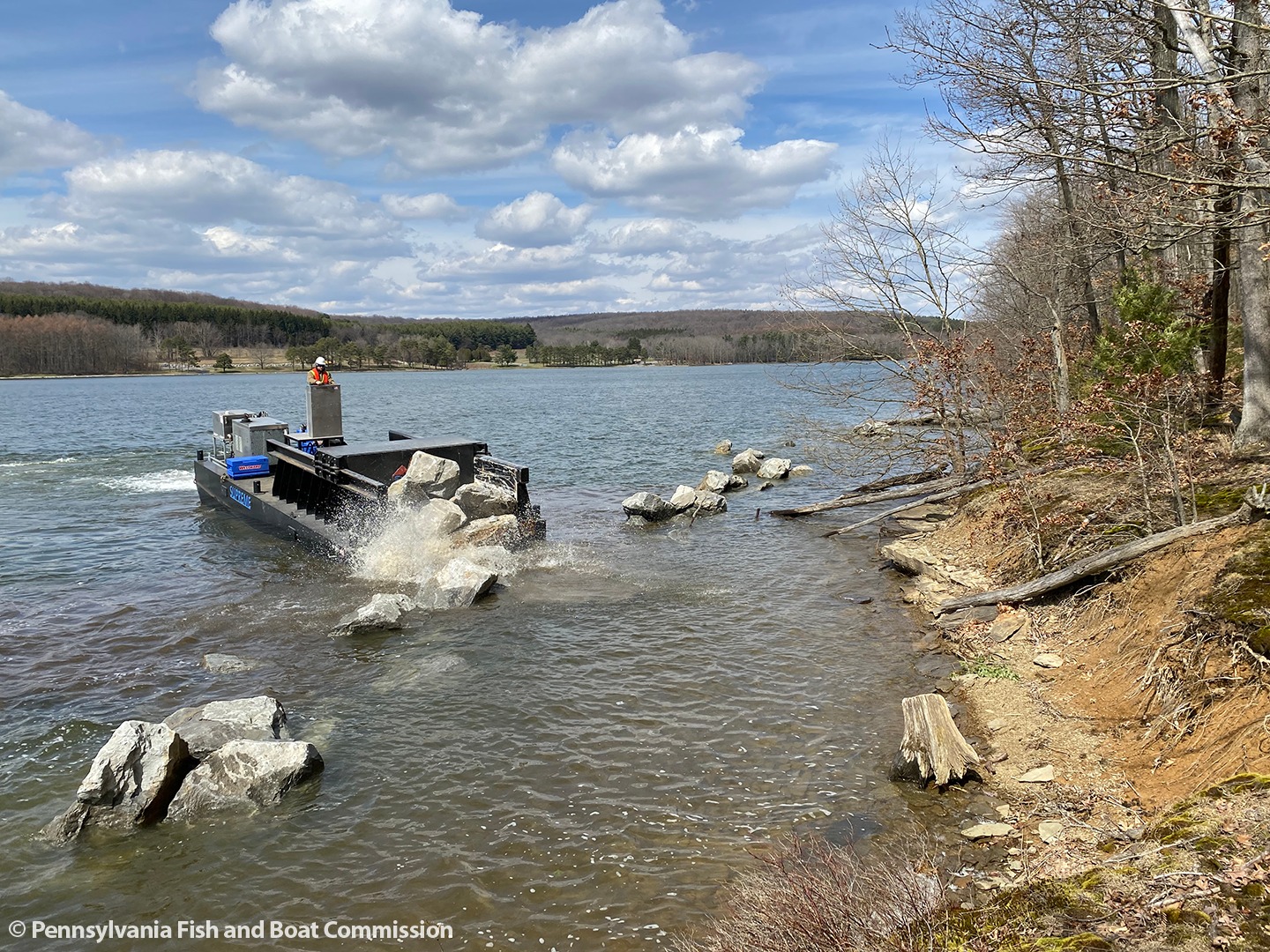
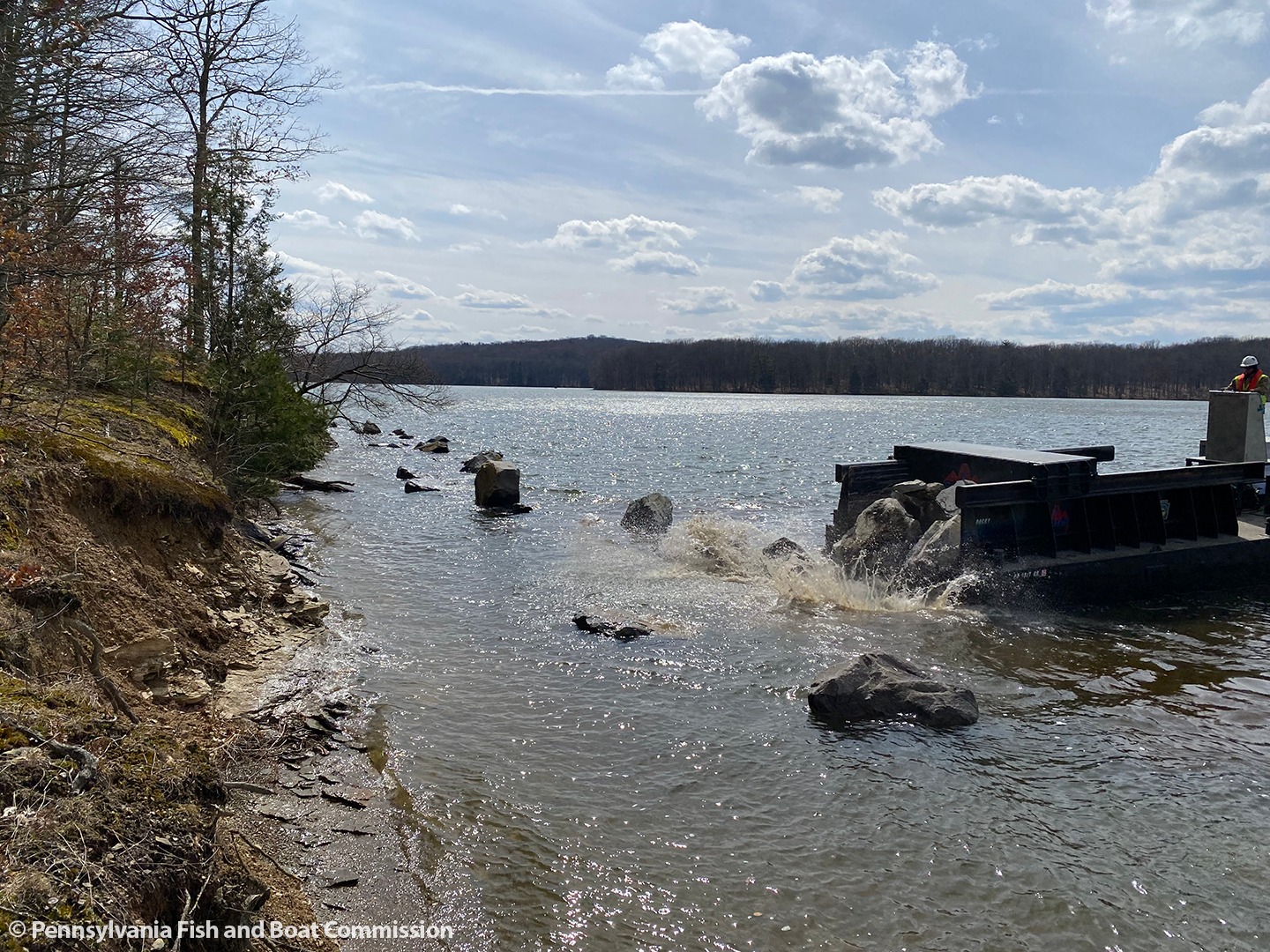
ROCK CROSS VANE AT PLUNKETTS CREEK
Structures like rock cross vanes help establish pool habitats for the fishery. Plunketts Creek, Lycoming County, is a naturally reproducing trout stream, and this section runs completely dry during long periods of dry weather during the summer months. Modified mud sills, log-framed deflectors and rock vanes were also installed in the stream channel to provide over-head cover and run habitat.
The PFBC partnered with the Pennsylvania Game Commission, Northcentral Pennsylvania Conservancy, Pennsylvania Department of Environmental Protection and Lycoming County Conservation District to install these structures on Plunketts Creek in 2021 and 2022. The project aims to improve stream habitat, stabilize eroding banks, restore the riparian buffer and reconnect the flood plain on 3,000 feet of stream frontage owned by PGC.
Crews also removed a levee to restore flood plain connectivity and establish a riparian buffer of trees, shrubs and wildflowers. Flood plain connectivity is important for flood stage water to have an area to distribute a large amount of water. The act of distributing flood stage water on the flood plain lessens its velocity and erosive forces in a natural way.
The final construction phase will be completed in 2023. PGC worked with the DEP and Army Corps to obtain permits for restoring Plunketts Creek.
FLEXING OUR "MUSSELS" - STOCKING PENNSYLVANIA-RAISED MUSSELS
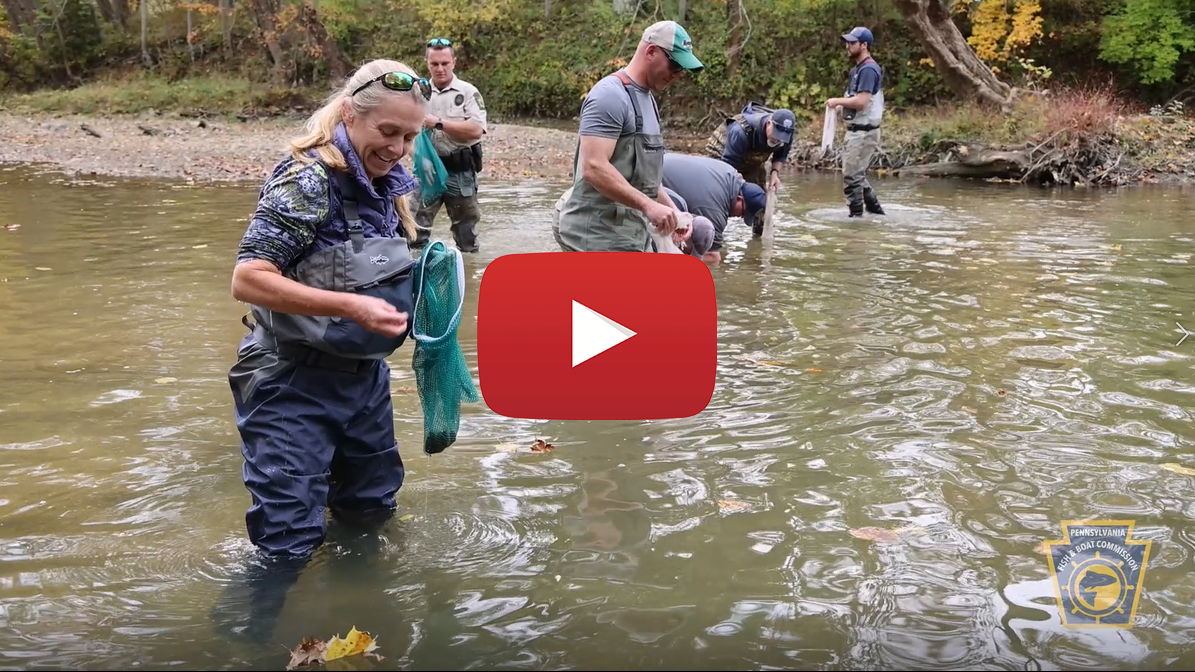
In some western Pennsylvania waterways, mussels have endured more than a century of environmental destruction.
In 2017, the PFBC came to their rescue, and this year brought mussel reinforcements to Dunkard Creek in Greene County on the PA/WV border.
The Commission grew the mussels in the Union City Aquatic Conservation Center (UC ACC), which was converted from a State Fish Hatchery and retrofitted with mussel propagation systems with funds from a 2009 fish and mussel kill settlement.
In October, Commission staff, with the help of DEP, gave just under 500 juvenile Plain Pocketbook and Fatmucket Mussels a new home in Dunkard Creek. And over the next year, the Commission will grow and stock another 40,000+ mussels to invigorate mussel populations and improve waterways across the state.
PFBC anticipates future stockings of greater numbers of mussels, more species and working toward eventual recovery of state endangered and threatened species.
Below is an estimate number of each mussel species raised at the UC ACC.
SPECIES
| JUVENILE <2mm
| JUVENILE 2-15mmm
| JUVENILE >15mm
| TOTAL
|
Fatmucket
| --
| 1,537
| 3,831
| 5,368
|
Plain Pocketbook
| 20,186
| 12,124
| 1,011
| 33,321
|
Wavyrayed Lampmussel
| 4,326
| --
| 3,849
| 8,175
|
TOTAL
| 24,512
| 13,661
| 8,706
| 46,864
|
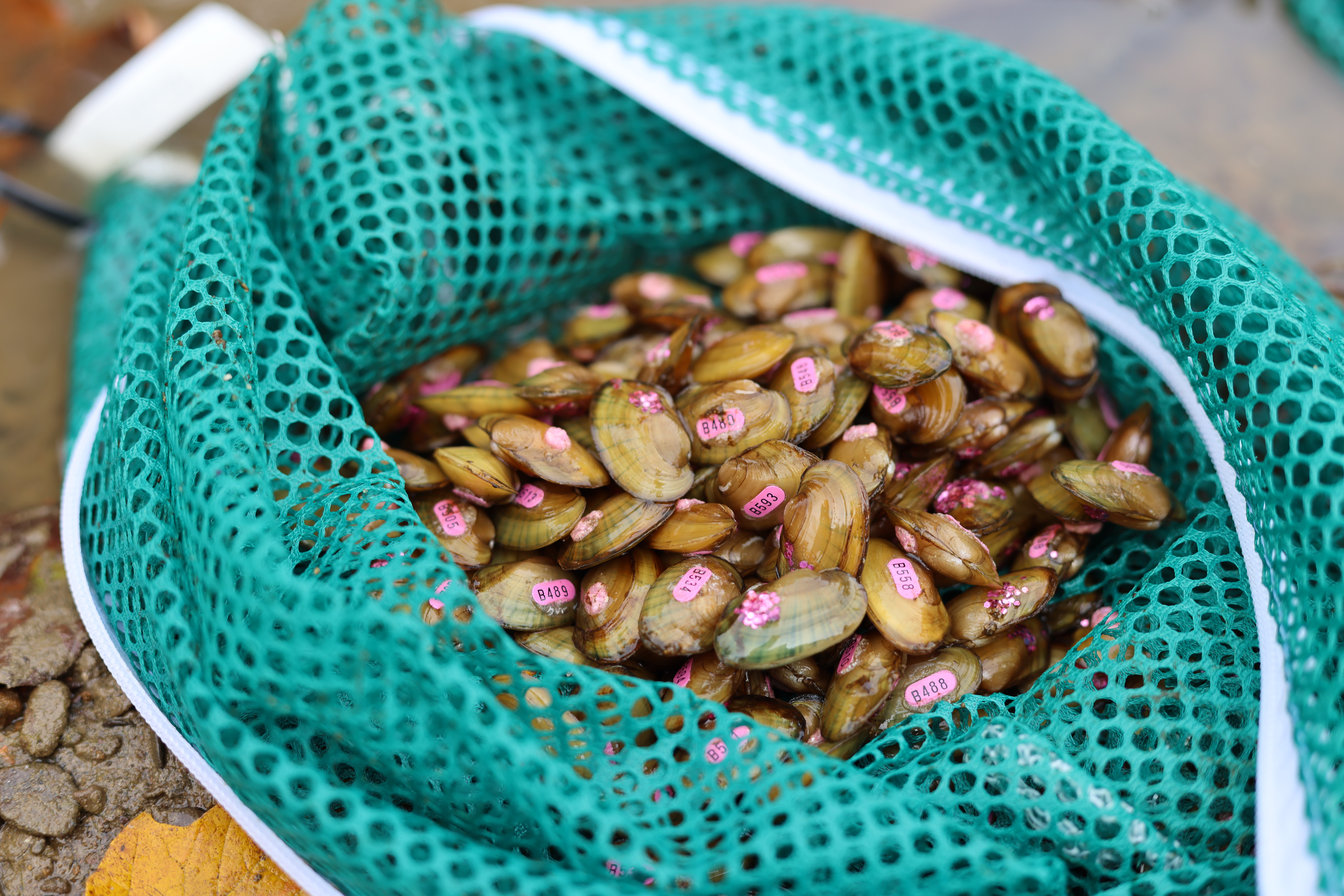
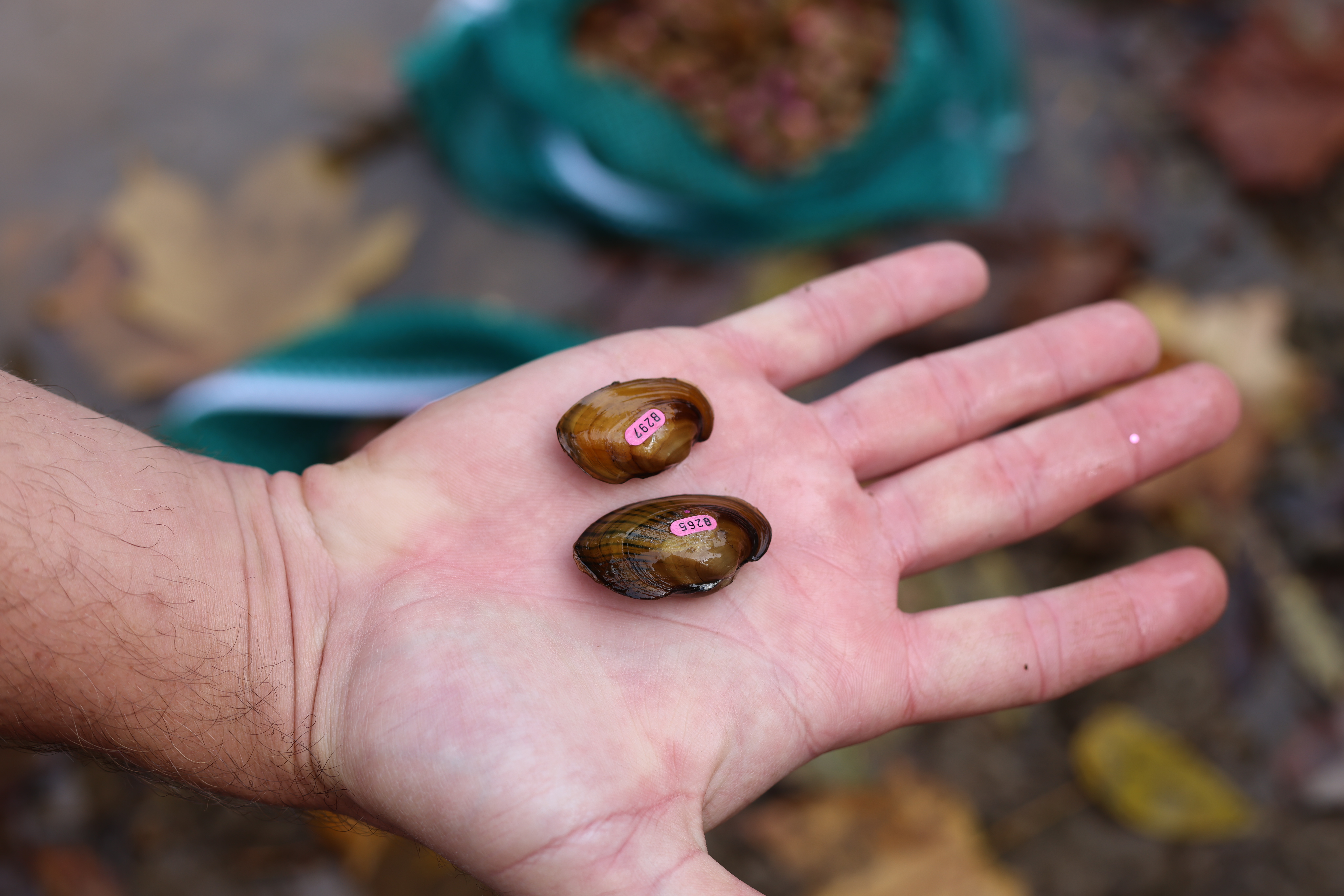
Close-ups of Plain Pocketbook and Fatmucket Mussels raised by the Pennsylvania Fish and Boat Commission.
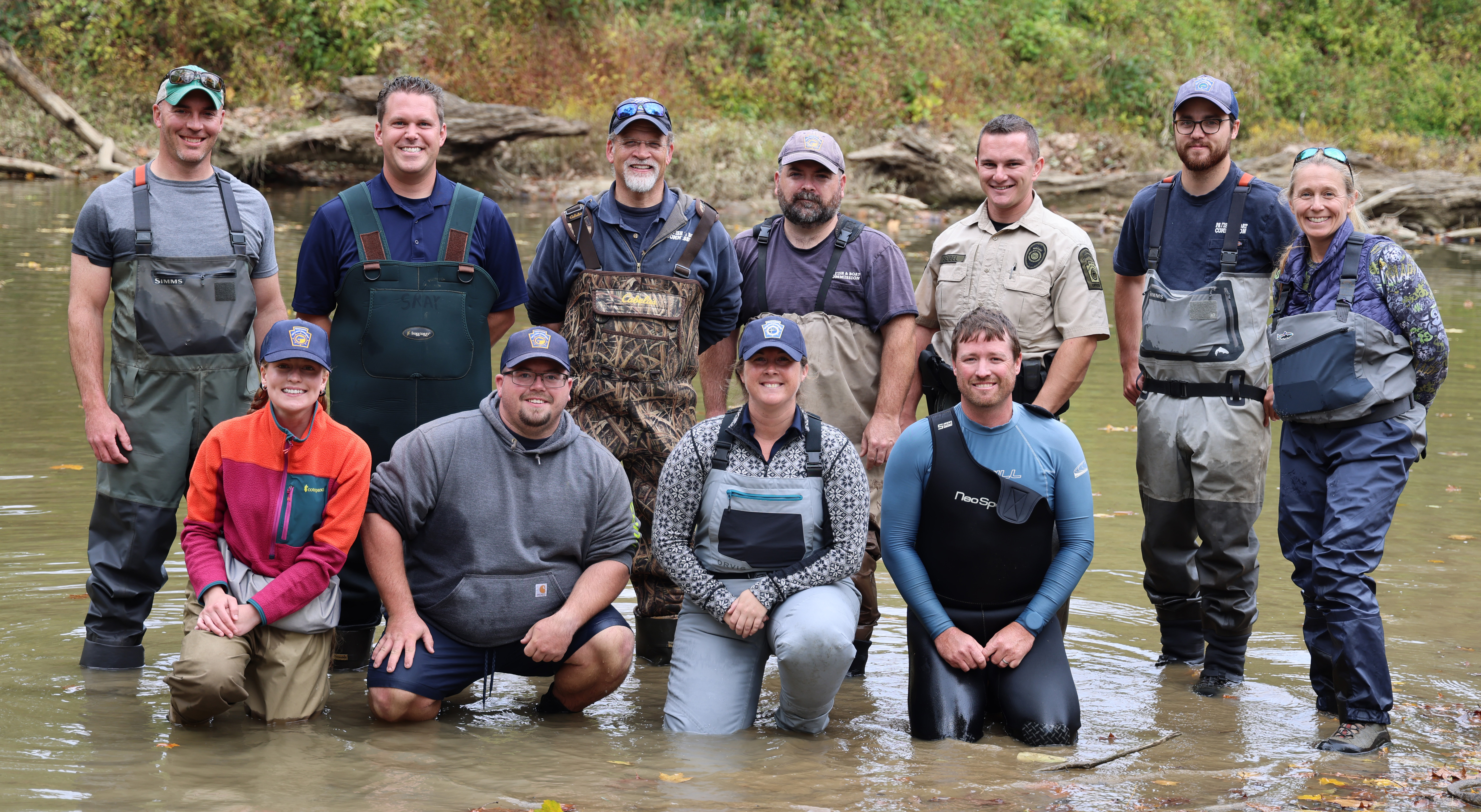
Group photo of staff from the Pennsylvania Fish and Boat Commission,
Department of Environmental Protection and volunteers.
SPRUCE CREEK HABITAT PROJECT
The PFBC and Western Pennsylvania Conservancy partnered to improve stream habitat, stabilize eroding banks and restore the riparian buffer on Spruce Creek, Huntingdon County.
The PFBC owns approximately 800 feet of stream frontage on Spruce Creek. The acquired property previously consisted of a parking lot, three house buildings and concrete wall structures. This section of Spruce Creek lacked in-stream habitat due to too much sedimentation and an over-widened and shallow channel.
Crews installed log cross vanes and log-framed deflectors to provide run and pool habitats, overhead cover and bank stabilization. The riparian zone was restored from the previous hard surface parking lot and buildings to 115 trees and shrubs and a wildflower pollinator garden.
PFBC Voluntary Wild Trout Permit and DEP Growing Greener funds were used for this project. Additional partners included Pennsylvania Department of Conservation and Natural Resources and Little Juniata River Association.
THREE RIVERS BLUE CATFISH RESTORATION PLAN
Efforts to restore Blue Catfish to the Ohio River basin in Pennsylvania are underway.
The Tionesta State Fish Hatchery
received eggs in the summer to become the first hatchery in Pennsylvania to raise Blue Catfish. PFBC staff stocked 40,000 Blue Catfish fingerlings in the Ohio River in October, and additional stockings will occur each fall from 2023 to 2026.
The
Three Rivers Blue Catfish Restoration Plan aims to establish a self-sustaining, naturally reproducing population of Blue Catfish in the Ohio, Monongahela and lower Allegheny rivers. Blue Catfish are native to the Three Rivers but were eliminated from Pennsylvania in the early 1900s due to pollution and habitat alteration.
Blue Catfish will only be stocked in the Three Rivers. They are not native to the Atlantic Slope basins in Pennsylvania, including the Delaware, Potomac and Susquehanna rivers and Lake Erie, and are considered highly invasive outside of their native range.
LITTLE PINE CREEK HABITAT IMPROVEMENTS
This section of Little Pine Creek, Lycoming County, has severely eroding stream banks that measure 16-18 feet tall by 300 feet in length. It's over-widened, void of natural habitat, and susceptible to further erosion that would send large amounts of sediment into the downstream reservoir.
In partnership with the Pennsylvania Department of Conservation and Natural Resources and the Northcentral Pennsylvania Conservancy, the PFBC Stream Habitat Section placed logs, root wads, down trees, stone, and boulders to help restore this section of Little Pine. The vertically eroding bank was stabilized using a saw-tooth modified mud sill, and the bank was graded to a 3:1 slope. At the base of the saw-tooth modified mud sill, a willow brush revetment, also referred to as live staking, was buried in. The willow cuttings have the ability to grow into new trees for additional stabilization. In total, the structure reclaimed 20 feet of lost eroded stream bank and stabilized a length of 300 feet.
The before picture shows the vertically eroding wall. The during photos show the saw-tooth modified mud sill and the willow brush revetment. The saw-tooth modified mud sill will provide overhead cover habitat for fish species and basking areas for reptiles and amphibians, as well as stabilize the eroding stream bank. The remediation shown in the after photo is a 3:1 sloped bank that was seeded with a riparian buffer wildlife mix and covered in straw mulch.
RAYSTOWN LAKE HABITAT PROJECT
The Pennsylvania Fish and Boat Commission recently partnered with the U.S. Army Corps of Engineers (USACE), Friends of Raystown Lake, PA Lake Management Society (PALMS), and the Reservoir Fisheries Habitat Partnership (RFHP) to improve recreational opportunities at the popular lake in Huntingdon County.
PFBC staff installed sawtooth deflectors to create a wind and wave break wall that will help improve a highly eroded shoreline. These rock deflectors will provide habitat for various fish species and improve macroinvertebrate colonization. Anglers will be able to target this area as a fishing hot spot for bass, walleye, panfish, and other species that will utilize the rock habitat throughout the year.
The structures will also improve water quality by reducing sediment and nutrients entering the watershed and allow a natural riparian buffer to reestablish on the lake shore behind the rock.
This project was funded by a $24,000 grant from PALMS.
Additional habitat projects are scheduled for September and 2023. Projects like these would not be possible without conservation-minded partners like Friends of Raystown Lake, Raystown Lake, U.S. Army Corps of Engineers, PA Lake Management Society, and National Fish Habitat Partnership.
Figure 1. A PFBC habitat barge installs sawtooth deflectors at Raystown Lake, Huntingdon County.
Figure 2. Sawtooth deflectors protect shorelines from wave action and will allow native wetland and upland plants to reestablish the buffer area along the shore.
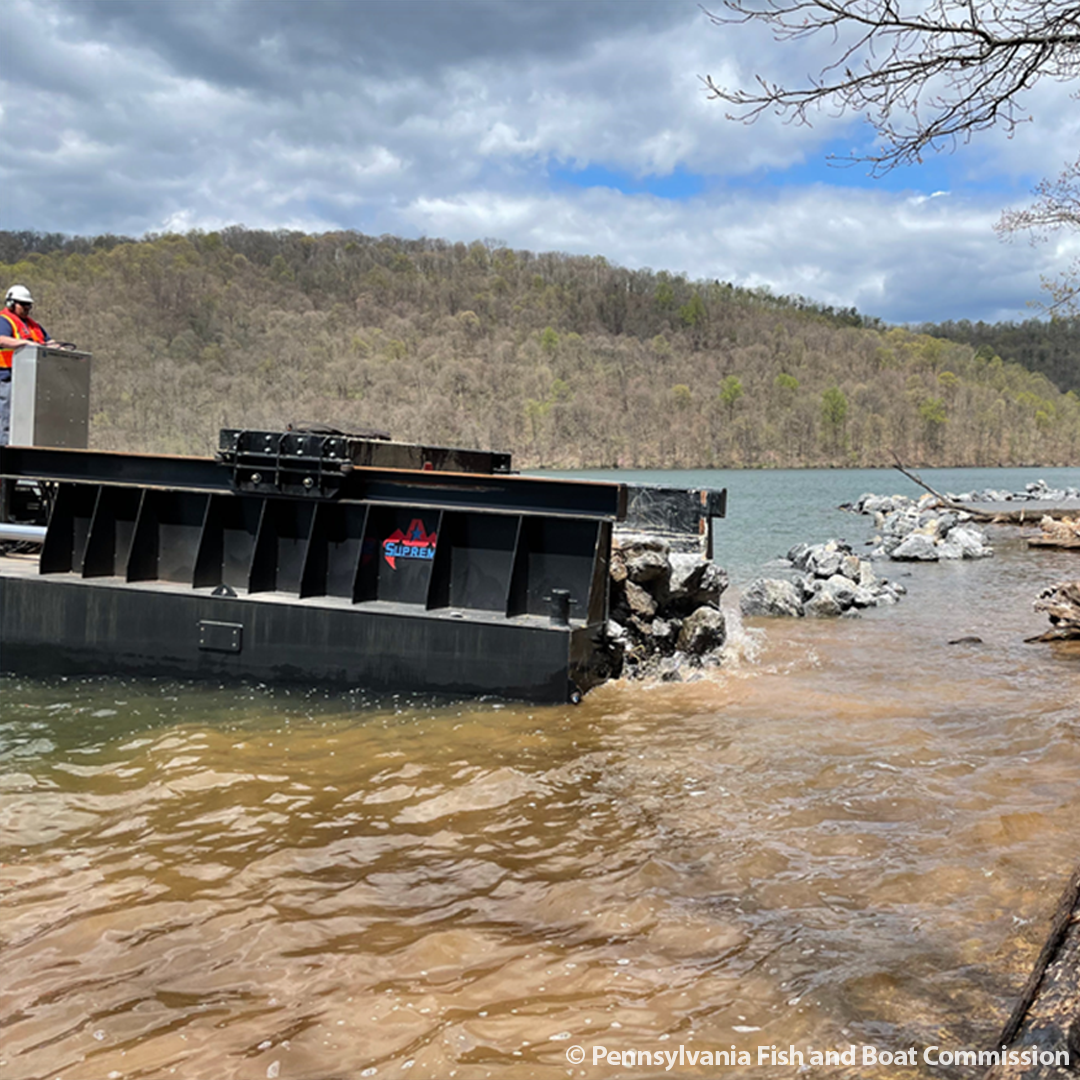
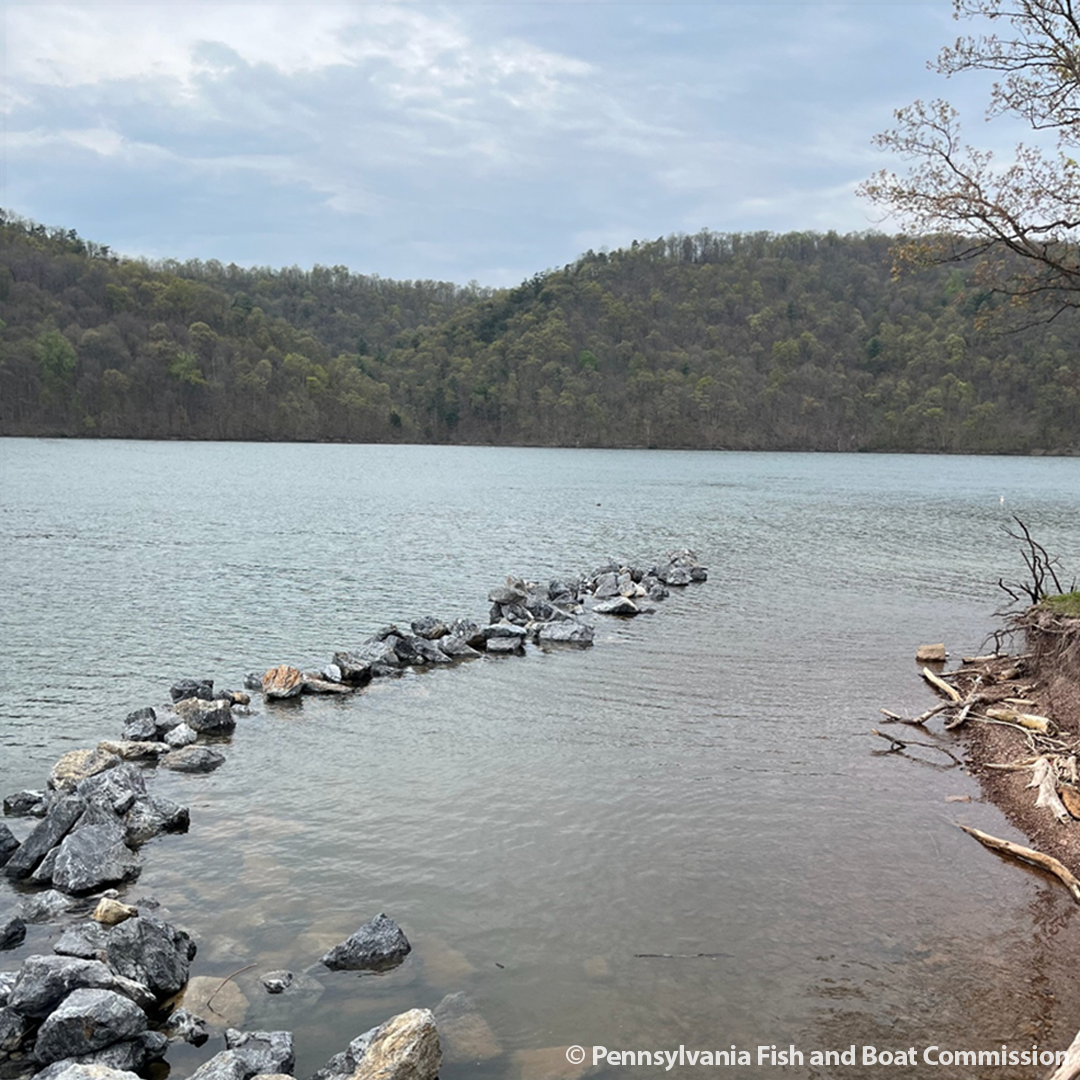
STREAM HABITAT WORK ON SPRING CREEK
The PFBC's Stream Habitat Section is working to restore a section of Spring Creek, Centre County, near the Shiloh Road access.
The before photo shows an over-widened section of Spring Creek and vertically eroding stream bank along the access road and biking trail. The erosion has resulted in lost fish habitat and increased sedimentation.
The after photo shows the installation of PFBC-designed log-framed deflectors. The deflectors will provide cover habitat for fish and basking areas for reptiles and amphibians, as well as stabilize the eroding stream bank and biking trail. The deflectors also immediately narrow the over-widened channel, which will help establish stream flows that allow natural stream transport of sediment to prevent deposition to the stream bottom. The deflectors were planted with a wildlife pollinator mix and covered in straw mulch.
The PFBC partnered with the Spring Creek Chapter of Trout Unlimited to conduct the project, which is being funded by PFBC Voluntary Wild Trout and Enhanced Waters Permit and DEP Growing Greener. All of the work performed was approved and permitted by PFBC and Department of Environmental Protection.
COLLECTING EASTERN LAMPMUSSELS
PFBC biologists recently collected some Eastern Lampmussels while sampling the West Branch Susquehanna River near Williamsport. Eastern Lampmussels are a rare species in the Susquehanna River watershed with limited distribution.
Mussels are indicators of water quality and can inform us if something is wrong long before other species can. If you like fishing or boating in Pennsylvania's streams, rivers, and lakes, then you like freshwater mussels!
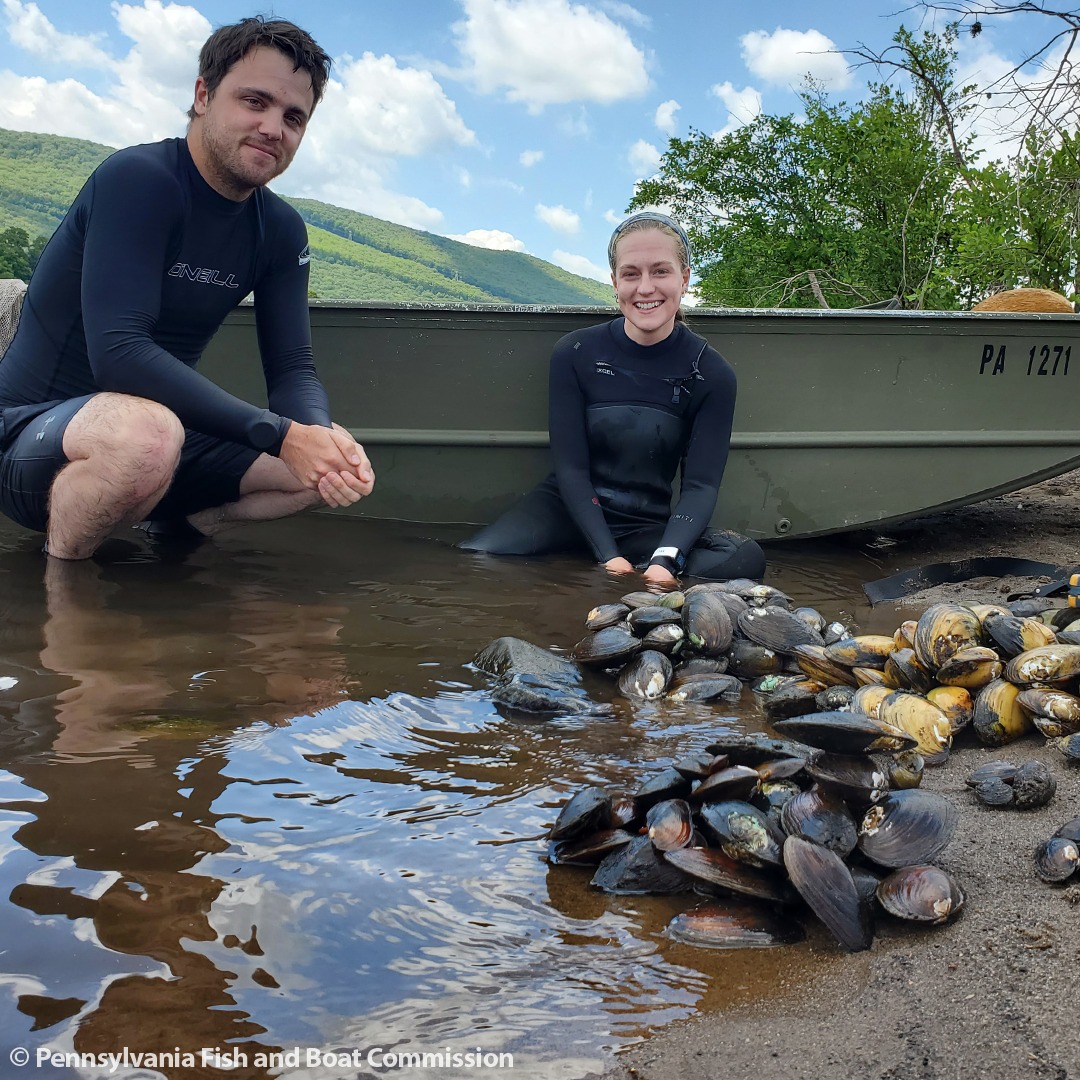
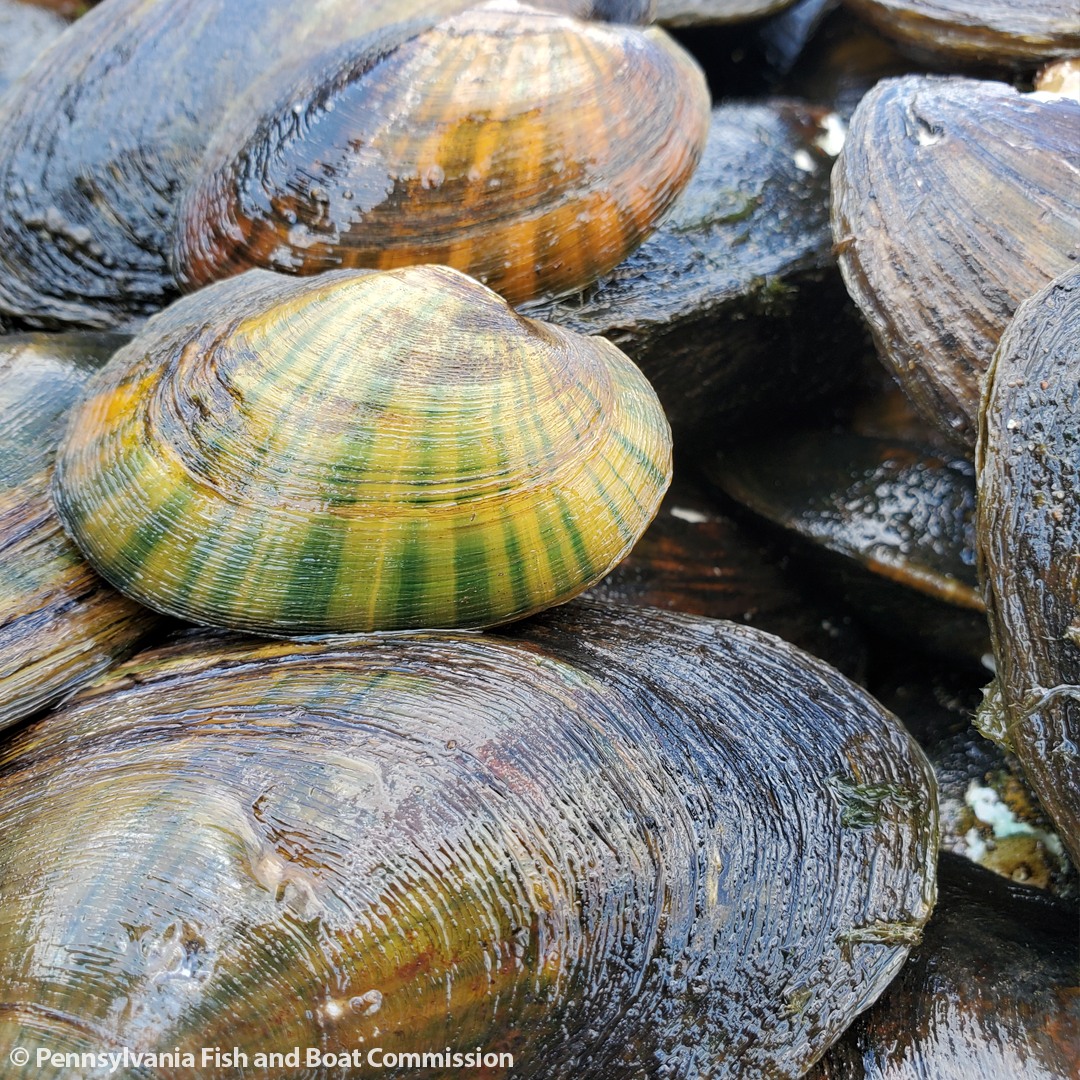
MINSI LAKE TURTLE BASKING PLATFORMS
Minsi Lake in Northampton County got some new turtle basking platforms and porcupine cribs, thanks to help from the Northampton County Junior Conservation School and Friends of Minsi Lake.
Water turtles use these platforms to bask in the sun, which helps them stay clean and healthy.
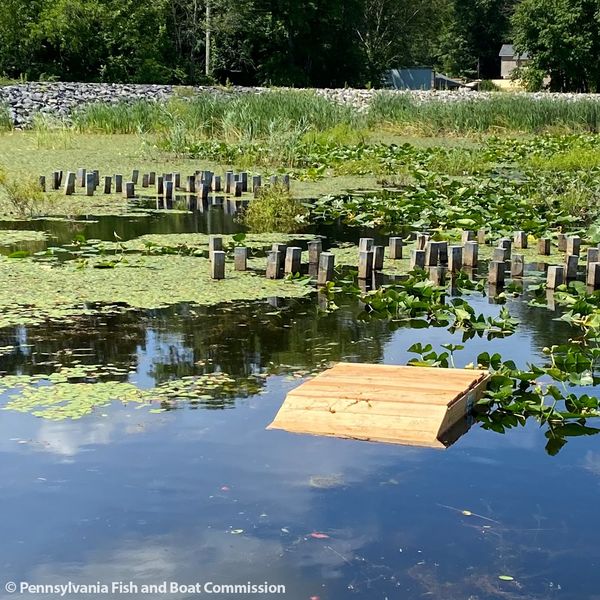
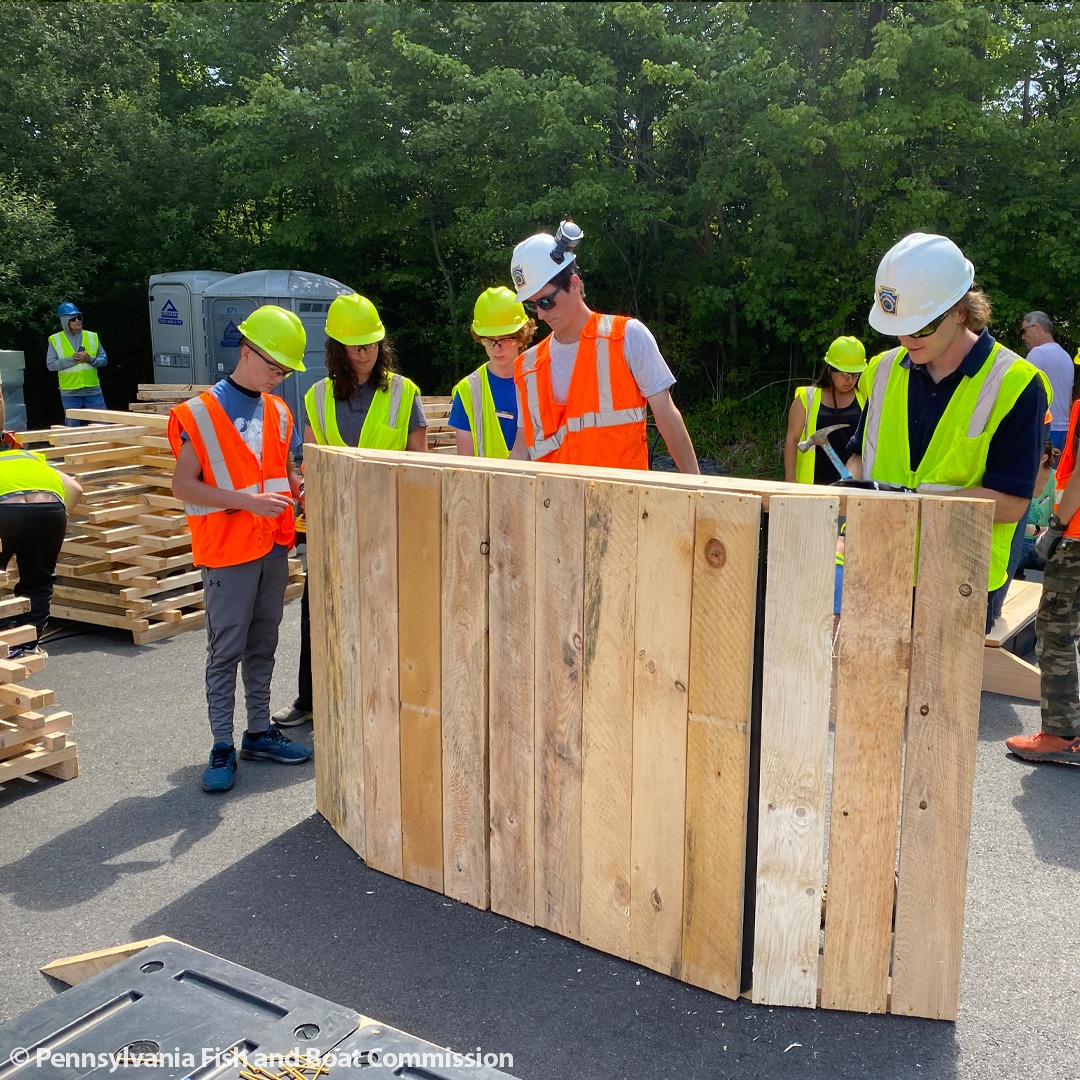
To learn more about our ongoing conservation projects, follow us on Facebook and Instagram.